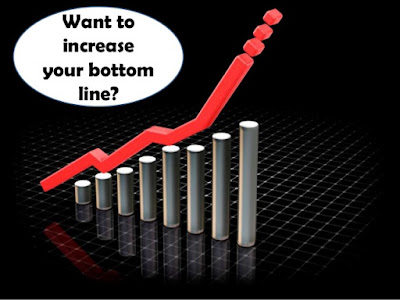How to Improve your Bottom Line?
Want to improve your bottom line? The answer is closer than
you think
Cost and efficiency: the mere mention of these two words is
enough to see any manufacturer break into a cold sweat. They are the two forces
that impact every manufacturing sector. So how can manufacturers successfully
optimize cost and efficiency to improve their bottom line?
Manufacturers are under growing pressure to improve
efficiency and lower costs. Traditionally this has meant struggling to find the
delicate balance between cost-cutting and product quality. This is made even
more complex with the high line speeds and frequent line changeovers – both of
which are becoming more common as manufacturers keep trying to push
productivity to the limits.
A large part of the solution lies in internally optimizing
processes and equipment. To see how this works in action, let’s take the
example of end of line packaging equipment:
1. Reduce total cost of ownership (TCO)
You can save money, increase your packaging equipment’s
performance and improve your workforce’s productivity all by simply
understanding the life-cycle costs associated with equipment ownership. In
fact, there is a genuine opportunity for manufacturers to dramatically reduce
cost of ownership and improve their bottom line. But what is TCO and how can it
be calculated?
Total costs cover both visible and hidden expenses, and
should generally be measured over a 3-5 year period. Visible expenses for
labelling and coding equipment, for example, would include:
-Capital
-Installation costs
-Consumables over the period
-Routine maintenance
-Corrective maintenance
-Service contracts
-Spare parts
Studies suggest that around 85% of lifecycle costs are
actually hidden:
-Downtime if the equipment breaks down
-Downtime due to routine maintenance tasks
-Shipping if the servicing is return-to-base
-Operator training
-Training time
-Time for product changeover
-Financing costs if equipment is leased
-Cost of disposal
By understanding the true cost of your packaging equipment,
you can take proactive steps to reduce the TCO and improve your bottom line. A
big part of this is choosing the right equipment provider in the first place. (See here for some thoughts on that.) For
example, the right provider can regularly inspect and maintain the packaging equipment,
with fixed-price service contracts, and provide the proper operator training. Setting
out the difference between preventive maintenance vs breakdown repair — it may
be a surprise to know that the true cost of a machine breakdown has been
estimated at between 4 to 15 times the maintenance costs!
You also need to weigh up the equipment capital cost versus
its ongoing running cost – a low capital cost but high running cost is a hidden
TCO.
2. Improve productivity and efficiency
The more efficient a manufacturer, the higher the potential
for profit. That much is simple – but in our increasingly competitive business
environment, the challenge for manufacturing companies is to find effective
ways to be more productive without compromising the quality of the products
going out the door. The second you start waiving quality and overlooking
regulatory and compliance standards, you say goodbye to customers.
But there are ways to improve productivity while maintaining
your high quality and compliance:
Vision inspection systems: automating quality control
provides major cost savings, due to reduced rework and more reliable product
quality. By using vision technologies to automate quality control of your
coding and labelling, you will reduce the potential for human error and enable
greater transparency throughout the process.
Checkweigh: By inspecting portion control of a packaged
product, checkweighers make sure that all packs leaving your factory door are
within the specified weight range, thereby eliminating unnecessary product
waste and reducing costs. Sitting at the end of a product line, checkweigh
technology can provide precision weighing at high throughput speeds and remove
overweight/underweight products from the line. It can also help manufacturers
detect any issues with product filling on the production line, allowing them to
correct the problem quickly and save costs.
Manufacturers can spend a significant amount of time, energy
and money in checking products manually, but checkweigh and vision inspection
systems allow for checks to be done automatically and accurately. Investing in
or upgrading your product ID and inspection equipment is a proven way to
streamline your existing processes and improve efficiency.
3. Measurement and visibility
How can you know where to improve efficiency if you haven’t
got visibility of your production line?
Overall Equipment Effectiveness (OEE)
is a best practice metric used by many manufacturers to measure productivity.
OEE identifies the percentage of planned production time that is truly
productive, so a score of 100% means represents perfect production with no
downtime. However, most manufacturing lines are only 60% productive, meaning there
is massive room for improvement.
Target: real-time production target established by the
planned rate of production
Actual: actual production count
Efficiency: ratio of target to actual, i.e. how far
ahead/behind production is running as a percentage
Downtime: accumulated downtime per shift in real-time
To see where to improve, you can’t rely on guesswork — you
need to put the procedures and technology in place to clearly see, measure and
drive efficiency. Coding and labelling equipment can easily keep product count
since it sits towards the end of the line to measure actual production count,
while inspection systems can keep count of the rejects.
Want to find out more on labelling, coding and inspection
solutions that can help increase productivity, reduce TCO and improve your
bottom line? Quick Pak Inc can help
you do all three.
Speak to us today 813 242 6995.




Comments
Post a Comment